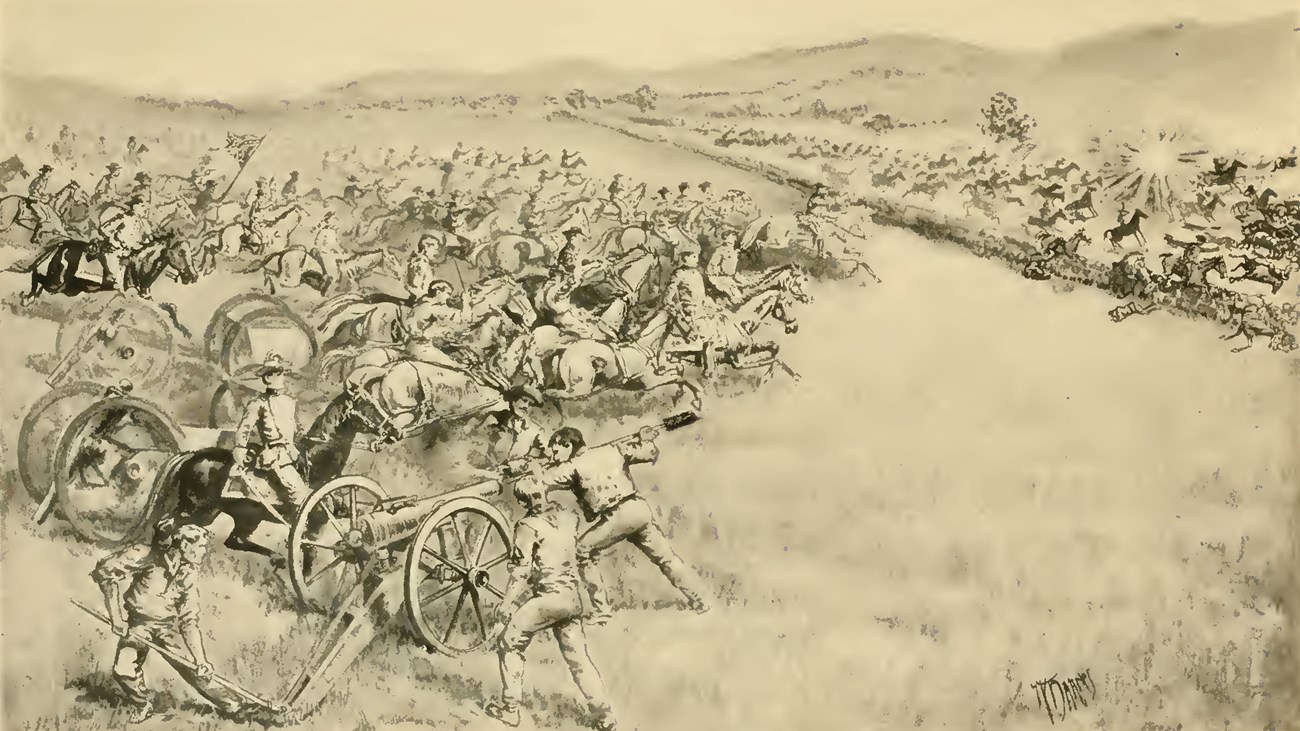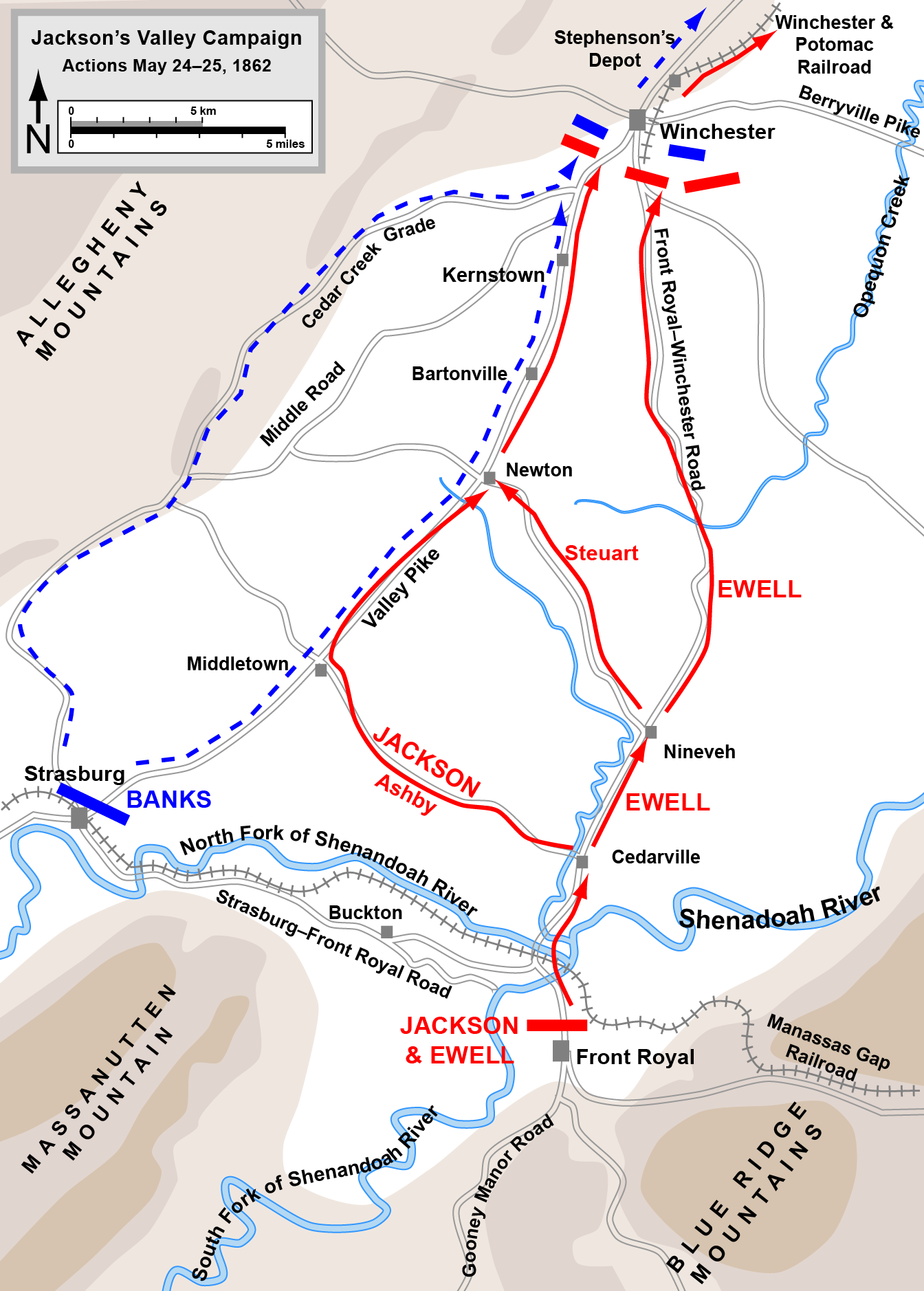Part of a series of articles titled If This Valley is Lost, Virginia is Lost.
Previous: Battle of Front Royal
Article

"Ashby's Charge at Middletown," illustration from "History of the Laurel Brigade," 1907
“It seems we were mistaken in our calculation.”
US Gen. Nathaniel Banks
By late May, the Shenandoah Valley Campaign of 1862 was going quite well for the Confederates. After losing at First Kernstown in March, forces under Maj. Gen. Thomas J. “Stonewall” Jackson received reinforcements and rallied to win the battles of McDowell and Front Royal. Jackson and his men had also held the Federal forces under Maj. Gen. Nathaniel Banks in the Valley and away from the Union invasion further east meant to capture the Confederate capital of Richmond. Now Jackson’s objective was to trap and crush Banks’s army near Strasburg, Virginia.
Although Jackson was pleased with his victory at Front Royal the day before, May 23, 1862, he faced a difficult decision. “In the event of Banks leaving Strasburg he might escape toward the Potomac,” Jackson wrote later, “or if we moved directly to Winchester, he might move via Front Royal toward Washington City.” To determine Banks’s intentions, Jackson sent troops toward both Winchester and Strasburg.
On the morning of May 24, 1862, Jackson ordered Brig. Gen. George Steuart’s Virginia cavalry to Newtown (now Stephens City), about ten miles north of Banks’s base at Strasburg, to see what he could find. What Steuart found was an endless line of Federal supply wagons heading north on the Valley Pike to Winchester. Confederate troops smashed into this line of wagons, the teamsters fled, but strangely enough, the Confederates did not burn the wagons, a move that would have blocked the Pike and severely slowed the Federal retreat.
Steuart then led his men south. As Steuart’s cavalrymen approached Middletown, they ran into Federal infantry – Banks’s main force – which scattered the Confederates, and the laborious Federal retreat north continued. Among this Federal column was most of Banks’s infantry, some of his artillery, and Banks himself. Also accompanying the Federals were hundreds of fleeing civilians, most of them escaping enslavement.
Banks and his army had abandoned Strasburg and crossed the Cedar Creek bridge on their march toward Winchester. Although Banks had left soldiers to burn the bridge across Cedar Creek after the last troops and wagons had passed, the Federal officer temporarily in charge of the rearguard decided to cross the creek at a ford and leave the bridge intact.
Hearing what Steuart’s men had found, Jackson decided to further split his command. He sent orders to Maj. Gen. Richard Ewell to advance tentatively on the Cedarville Road towards Winchester, while ordering Brig. Gen. Richard Taylor to take his Louisiana brigade, with some artillery and cavalry under Col. Turner Ashby, west on the Chapel Road to Middletown. Around 3:30 p.m., as Taylor’s column neared the Valley Pike north of the town, more of the Federal wagon train moving north came into view.
Taylor ordered his artillery to unlimber and fire at the wagons. The damage to the Federal wagon train and nearby cavalry was terrific, and most of the teamsters fled. Caught in a hail of both musketry and artillery fire, many of the exposed Federals were slaughtered in the streets. When Jackson arrived about a half-hour later, while pleased with the destruction, he was more interested in locating and crushing the Federal infantry.
Not knowing most of the Federals had already passed to the north, Jackson ordered Taylor south, through Middletown, to see if Banks’s main force was marching north from Strasburg. As Taylor’s men advanced, they were cheered by Middletown’s citizenry. One Confederate veteran wrote, “Everything… turned out to greet us, men, women, girls, children, dogs, cats, and chickens…” Many of the undisciplined Louisiana Zouaves in their colorful uniforms with baggy pants looted the abandoned Federal wagons.
Approaching the southern end of Middletown, however, the Louisianans received enemy fire from the Federal rearguard of Zouaves and more cavalry under Brig. Gen. John Hatch. “As we jumped over the stonewall into the pike, a vicious volley of bullets whistled through our disordered ranks, splintering the rails of the neighboring fence and wounded several of my comrades,” Private Henry Handerson of the 9th Louisiana remembered, “and looking down the road towards Strasburg, I saw a company of Zouaves firing vigorously upon our advance.”
Those Zouaves were members of Colonel Charles H.T. Collis’s Zouaves d’Afrique, a company of about one hundred soldiers who formed General Banks’s headquarters guard. Although Banks had already ridden north, he had ordered Collis to stay behind with the rearguard, see that the rest of the wagon train got out of Strasburg, and that anything of military value left behind be destroyed, including the bridge across Cedar Creek.
Collis led his men to a stone wall perpendicular to and along the right side of the Valley Pike just south of Middletown. As the Louisianans approached, Collis’s men opened fire. Many of these Confederates were Zouaves of Major Roberdeau Wheat’s special Louisiana Battalion, better known as the Louisiana “Tigers."
Collis’s men fired three volleys, then fell back to a ridge about a half-mile south, across the pike from Belle Grove Plantation, taking position to the right of Captain R.B. Hampton’s Battery F, Pennsylvania Light Artillery (Hampton had four 10-pound Parrott rifled guns). Soon joining Collis and Hampton were more of Gen. Hatch’s cavalry including five companies of the 1st Vermont Cavalry, and a bit later, six companies of the 5th New York Cavalry.
Taylor’s Louisianans tested the Federals from a distance, but did not seriously challenge them, allowing what remained of the isolated Federal rearguard to pull back south across Cedar Creek. This time, the Federals burned the bridge, hoping to slow the pursuing Confederates. Collis and the rest of the rearguard took refuge in earthworks on Hupp’s Hill near Strasburg where they expected to be attacked, but the Confederates stayed on the north side of Cedar Creek, in the shadows of the burning bridge.
Collis and the rest of the rearguard eventually moved west, then north, to reunite with Banks’s command. Unable to find Banks, they continued all the way to the Potomac River, reaching Hancock, Maryland, on May 26th. They had marched over 140 miles in under two days.
By 5:45 p.m. of the 24th, Jackson finally realized that his men faced only a rearguard, and he ordered Taylor to turn around and head north. He also sent word to Ewell, still on the Cedarville Road, to do the same. It now remained to be seen whether Jackson could catch Banks’s column before the Federals reached the relative safety of the hills south of Winchester. Jackson had wasted approximately two hours trying to wreck the tail of Banks’s army, hours that could have been used to intercept the main body.
The Confederates could not catch up to Banks’s men. Although they passed dozens of captured or abandoned wagons – “the streets were lighted up by the burning of a commissary train, especially the flames from the burning bacon and from wagonloads of rice,” one Confederate recalled – they couldn’t catch Banks’s infantry. Forming the Federal rearguard were the 2nd Massachusetts, 27th Indiana, and 28th New York Infantry Regiments. These units held the Confederates off as the retreat to Winchester continued.
When the men of both armies neared Winchester, the Federals occupied positions on the hills south of town, and the Confederates stopped just north of Kernstown, some units not reaching their destinations until the early morning hours of May 25th. Many troops from both sides collapsed from exhaustion. The fight was not over, though; it would be continued later that day during the First Battle of Winchester. Jackson had won at Front Royal the day before; could he now trap and destroy Banks in Winchester?

Map by Hal Jespersen, www.cwmaps.com
Part of a series of articles titled If This Valley is Lost, Virginia is Lost.
Previous: Battle of Front Royal
Last updated: October 22, 2023